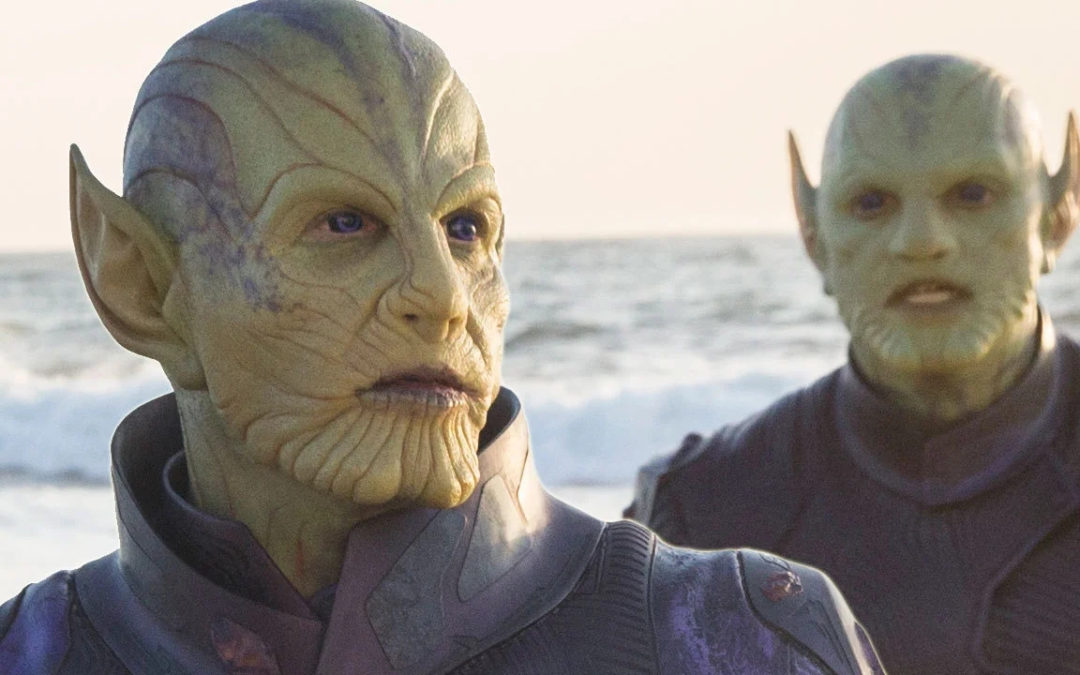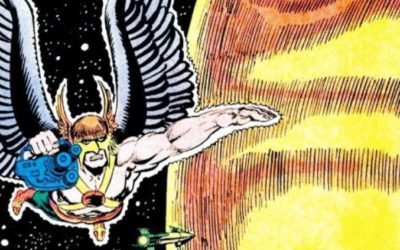The Skrull are one of the oldest threats to the earth in the Marvel Universe.
The green, wrinkly-chinned, pointy-eared, shapeshifting aliens have had a heck of a run. While Marvel movie fans first spotted them in Captain Marvel and Spider-Man: Far From Home, they’ve been around in the comic books since their first appearance: Fantastic Four #2 in 1962 (and las later stories revealed, even before that). In the story, four Skrulls came to earth and shapeshifted to imitate the members of the Fantastic Four, make them wanted criminals and destroy the public’s trust. The Four would be hunted down and killed or imprisoned, clearing the way for a Skrull invasion.
The Four stopped them, and the invasion was called off, thanks to some trickery by the FF. Later, since no prison could hold them, Richards hypnotized the Skrulls to shapeshift, and fully believe that they were cows. He literally put them out in a pasture and walked away
Yeah – Skrull cows were gleefully played with fin the years since then by creators in the Marvel Universe, but Reed’s decision came back to bite him in 1983’s Fantastic Four Annual #17 by John Byrne, which addressed the issue of milk from Skrull cows, and the offspring of Skrull cows. At the time, it was a fun story, but looking back on it – it’s quite disturbing.
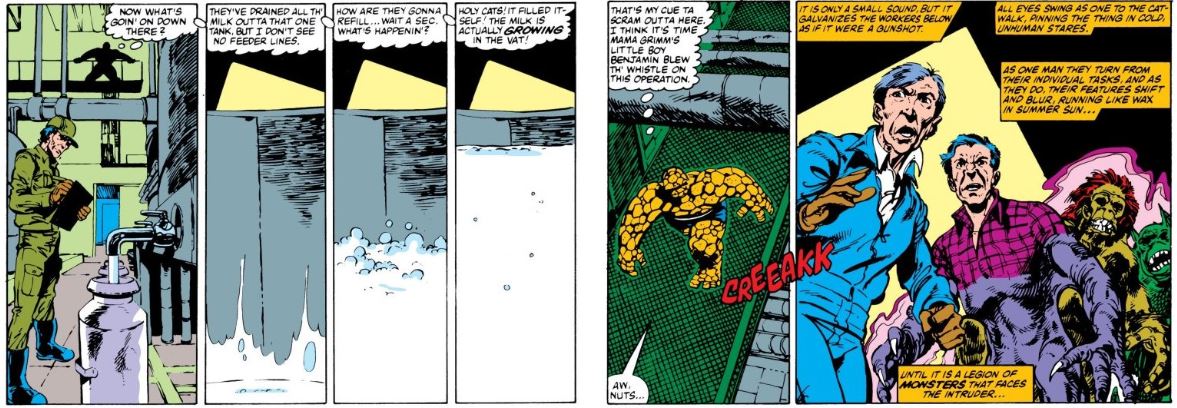
Milk from Skrull cows grows. Yeah. Cool. (c) Marvel Comics
In the nearly 60 years since their introduction, the Skrulls have been developed by countless Marvel creators into an intergalactic empire – one of the oldest in the universe at around 60 million years. Throughout their history, they have been warriors, peaceful benevolent conquerors, spies, invaders, and allies or enemies to the earth and every other star-spanning race in the Marvel Universe. In 2008’s Secret Invasion, it was revealed that several heroes in the Marvel Universe, were in fact, Skrulls, which sowed the seeds of deep mistrust between earth’s heroes.
Coming this summer in the multi-series crossover, Empyre, the Skrulls are back to playing a central role in the Marvel Universe, this time being forced to team with their hated enemies, the Kree, in order to face a new danger which is a threat to both races as well as the earth.
It’s a good time to be a Skrull.
But just how many of them are there? They’re an empire, after all. There should be a lot, right?
There are.
But aside from snooping around on earth, where are they?
Skrull empire is based in the Andromeda galaxy which they have effectively conquered, colonized, or otherwise occupied, well, as Reed Richards explained in 1986’s Fantastic Four Annual #19:
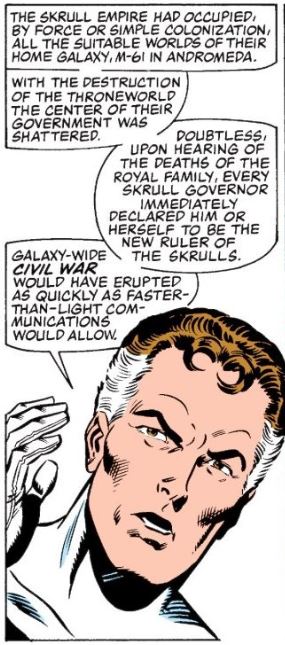
Reed explaining where the Skrulls live, from FF Annual #19. It’s called “Reedsplainin – and yeah, he got the Messier number wrong. It’s M-31. (c) Marvel Comics
Oh – I forgot to mention that time Galactus ate the Skrull throneworld which Reed referred to…
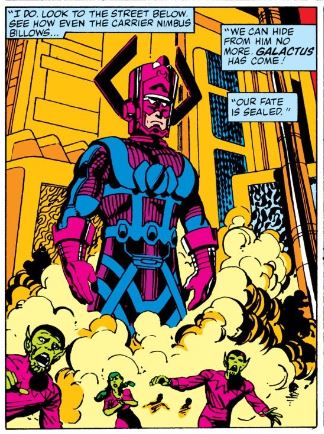
This did not end well. From Fantastic Four #257 from 1983. (c) Marvel Comics
Despite setbacks, there are a lot of Skrulls. Now – there are also some claims that the Skrull Empire has “laid waste to thousands of galaxies,” which I’m going to ignore for the moment partly due to the resources issue, but mostly due to the idea that all empires throughout history have engaged in hyperbole to build themselves up to much more than what they are or were.
Let’s just say that they live in the Andromeda galaxy, and the entire galaxy is under Skrull control.
So that means…how many Skrulls again?
To figure that out, we need to answers some other questions first.
Oh, and now is as good a time to say it as any – there’s no payoff to the title of this article.
Onward!
Skrull Home: Andromeda History & Basics
Though the home galaxy of the Skrulls is visible to the naked eye (you can find out how to spot it here) The first recorded sighting of what we now call the Andromeda Galaxy came in 964 CE by the Persian astronomer Abd al-Rahman al-Sufi who just saw it as a smear in the sky, resulting in it being referred to as a nebula contains within the Milky Way for centuries. It was first sighted by Simon Marius through a telescope in 1612 and referred to as an “island universe” by Pierre Louis Maupertuis in 1745. Astronomer Charles Messier cataloged it as M-31 in 1764, and while its spiral structure was distinguished in 1850 by William Parsons and it was photographed in 1887 by Isaac Roberts, the body was still thought to be a nebula. A spiral one, obviously.
By the way, astronomers will still call it M-31 or “Andromeda,” while the general public knows it as “Andromeda. If you slip up and call it, “home,” we know you’re a Skrull.
More evidence that the “Great Andromeda Nebula” was actually its own galaxy accumulated in the early 20th century, with Edwin Hubble conclusively proving that Andromeda was a galaxy in 1925. Hubble observed a specific type of stars called Cepheid variable stars within the “nebula,” which indicated that it was its own galaxy; and was also able to determine its distance from the Milky Way: roughly 2.5 million light-years.
Just a quick reminder – any picture you’ve seen of the Andromeda Galaxy is a picture of how it looked roughly 2.5 million years ago. To look into space is to look back in time, after all. Oh, and the Skrulls have space-warp technology that can put them near the earth pretty quickly.
Another of Hubble’s findings is that Andromeda is one of the few galaxies in the universe that is moving toward us. It’s moving at roughly 110 kilometers per second, which causes the wavelengths of light coming from Andromeda’s stars to compress a little, pushing them towards the blue end of the visible light spectrum, a phenomenon referred to as blueshift. If a celestial object exhibits a redshift, it is moving away from us, the observer. Collectively, these effects are known as Doppler Shift. We’ll hit this again in a minute.
As a result of its movement toward us, the Andromeda Galaxy will collide with the Milky Way Galaxy in four to five billion years, resulting in a new, larger galaxy. Skrulls are going to move in with us. Yay.
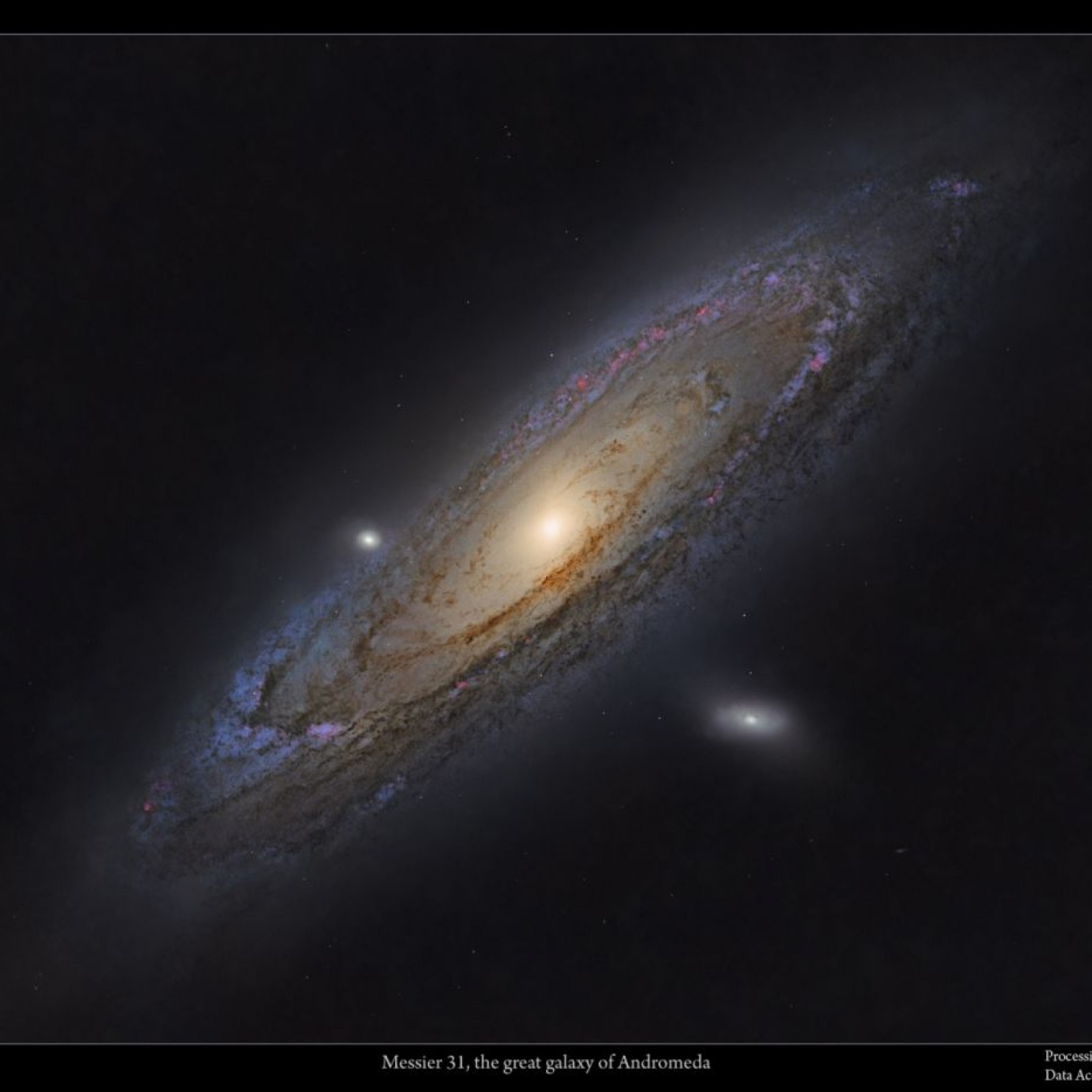
Andromeda, or M-31, with two of its most prominent satellite galaxies, M-32 (left of center) and M-110 (lower right)
Andromeda’s Characteristics
The Andromeda galaxy is slightly younger than the Milky Way – approximately 10 billion years compared to approximately 14 billion years.
Compared to ours, Andromeda is relatively quiet: it doesn’t produce as many new stars as the Milky Way does (roughly 1 new star shows up in Andromeda for about every 4 here), and it has about half as many novae – stars exploding at the end of their respective lifespans.
Size-wise, the Skrull’s home galaxy is roughly the same as the Milky Way. In terms of dimensions, Andromeda’s diameter is about 220,000 light-years, while the Milky Way is roughly 200,000 light-years. In terms of mass, the most recent studies point out that both galaxies are roughly the same as well. Galactic mass is measured in terms of solar masses, that is, multiples of our sun – hey, you use what you have – and Andromeda is roughly 1.0 – 1.2 x 10^12 solar masses, compared to the Milky Way’s 0.8 – 1.0 x 10^12 solar masses. A solar mass or the mass of our sun is 2.0 x 10^30 kilograms.
Due to the diversity in the mass of individual stars, the correlation between the galactic mass and the number of stars isn’t 1:1 – but it’s close. Andromeda is estimated to contain on average, roughly 1 trillion stars, compared to the Milky Way’s range of somewhere between 100 – 400 billion stars.
Like the Milky Way, Andromeda has many smaller, satellite galaxies and globular clusters of stars associated with it – about 460 globular clusters within it, and around 20 satellite, or dwarf galaxies around it, including M-32 and M-110, which are easily spotted in photos of Andromeda like the one above.
All in all – there are a lot of stars in and around Andromeda that are if we believe the Marvel Universe cosmology and Skrull Empire hype, controlled by the Skrulls.

Just part of the 1.5 billion pixel image taken by the Hubble telescope of Andromeda. For the full version click here, and click here for a zoomable, web version.
Which is all well and good, but while they are shapeshifters, Skrulls can’t live on stars. They need planets to survive on. So the question we need to ask is, “How many planets are in the Andromeda Galaxy?”
Before we can make that estimate, we need to ask another question – how do we know there are any planets in Andromeda? And that question needs another question before it – how do we know there are planets out there other than what’s in our own solar system?
Let’s find the planets.
Wait, How Do We Find Planets?
Our solar system has eight or nine planets, depending on which side you land on regarding Pluto. PLanets outside of our solar system are called exoplanets, which just signifies that they are “outside” (exo) of our neighborhood.
You could argue that humans had known intuitively that there were planets circling other stars – luminaries like the Italian philosopher Giordano Bruno theorized the idea of other solar systems, as did Isaac Newton in his Principia. But in terms of fact, we’ve only known for about 20 or 25 years that planets outside our solar system actually exist. But in that short time, our catalog of worlds out there has grown to number in the thousands of all types – rocky, gas giants, frozen worlds, and more. Finding them though – that’s the result of a collection of beautiful tricks of observation and inference.
There are three ways:
Exoplanet Detection Method 1: Radial Velocity
Stars and planets have dynamic relationships, wherein the planet pulls on the star while the star pulls on the planet. The star is, of course, many, many times larger than the planet, and as a result, the planet orbits the star. But the planet’s effects on the star cause it to wobble away from the center of gravity of the planet-star system—just a little. Small planet, small wobble. Big planet, big wobble. More than one planet, complicated wobble.
From a vantage point near Earth, this wobbling star has regular and predictable movements that take it ever so slightly closer to Earth and then farther away again. This causes a change in the light that can be observed coming from the star, due to the Doppler shift. That’s how we know Andromeda is headed towards us: as the star moves away from Earth, the light waves coming from it are stretched a little, and their wavelength is increased.
Red light has the longest wavelengths, so as something is moving away from Earth, it’s said to be “redshifted.” If the star is moving toward Earth again, even minutely, the wavelengths of light are squeezed just a little. Blue light has shorter wavelengths, and as such, objects moving toward Earth are said to be “blueshifted.”
Looking at stars with planets, or whole planetary systems, we see that the light modulates through the color spectrum, thanks to the wobble caused by the tugs and pushes of the bodies that cause the star to jiggle toward Earth and then away, over and over, periodically. When the data is analyzed with other instruments, the amount of color shift can indicate the planet’s mass (bigger, denser planets have more pull than smaller, less dense ones, which may not move their star by an amount detectable by Earth-bound tools), and that data can be combined with other methods of detection to build a fuller, more complete picture of the exoplanet.
At no time is an exoplanet ever seen by radial velocity alone. While this method has resulted in some exoplanet discoveries, it is more often used in conjunction with other methods, such as transit, to confirm suspected exoplanets.
Exoplanet Detection Method 2: Transit
You know that scene in a horror movie in which there’s a doorway at the end of a long, dark hallway, and suddenly there’s a shadow in front of it, but then it’s gone. Was it the killer? Was it even human? Where did it go? Instead of killers and hallways, imagine a star light-years away. As you look at the star, occasionally something apparently passes in front of it, causing the amount of light to dip just a little. That thing is most likely a planet, transiting in front of its star.
That’s how most exoplanets have been discovered: the light from distant stars decreases just a little as the planet passes between its star and our telescopes. The amount of dimming is far too small for the human eye to perceive, so other instruments are used, such as the (recently retired) Kepler Space Telescope and the Transiting Exoplanet Survey Satellite (TESS).
When a planet transits in front of its star, scientists can determine all sorts of information about it: the planet’s size, its atmosphere, even its composition and temperature. That’s how we know that there are exoplanets with methane, oxygen, and water vapor in their atmospheres, even though we’ve never laid eyes on them, and our best pictures of them only show blobs near another blob.
The transit method isn’t perfect, though, and some planets, orbiting at just the right position, could be invisible to our instruments, while other signals that seem to indicate the presence of a planet may be false positives. Nearly three thousand exoplanets have been discovered with this method.
Exoplanet Detection Method 3: Direct Imaging
Sometimes, exoplanet hunters can just get lucky. If a planet (or planets) is orbiting at just the right distance from its star, it can be discovered the old-fashioned way: by looking at it. First scientists have to block the light from the planet’s star, the same way you would hold your hand up to cover the sun so you can more easily spot something outside on a sunny day. The “hand” in this case is either a coronagraph—a disc inside a telescope that can be positioned over a star—or a starshade, which is a separate spacecraft positioned near a space telescope that can be maneuvered to block starlight from various stars, allowing astronomers to observe the planets in their orbit.
This method is best for large, hot planets whose infrared radiation can be seen with specialized telescopes on Earth, but it also works with planets orbiting small brown dwarfs (which aren’t quite full fledged stars). It’s even been used to spot rogue planets—planets that wander through space without a star. Put that on your nightmare list for when you’re looking for something to worry about at night.
When the James Webb Space Telescope is launched next March, it will be able to spot exoplanets (and a lot more) via direct imaging.
Exoplanet Detection Method 4: Gravitational Microlensing
Thanks to Albert Einstein, we know that massive objects, like stars, can warp space-time, and as a result of this warping, light itself gets bent and distorted as it travels near these objects. Under the right conditions, and with the right objects, light can bend in a fashion that can be observed and measured using instruments on Earth.
If a star with its attendant exoplanet has enough mass, it can cause the light coming from an object behind it to be focused periodically, resulting in a brighter-dimmer-brighter pattern as it travels. Spotting a microlensing event such as this is rare, but they have been observed, especially when large portions of the sky are viewed for long periods of time, a task made easier with automated telescopes. From the microlensing event, the mass of the object or objects causing the phenomenon can be calculated.
Andromeda’s Planet?
The number of exoplanets that have been discovered since the field really took off in the early 200s is literally always climbing. As of June 1st, 2020, the count was 4268, and that number is probably already out of date. All of these planets have been spotted outside of our own solar system but in our local region of the Milky Way. Well, except for one. Possibly.
PA-99-N2 was a gravitational microlensing event that was announced in 2009, and according to the researchers, spotted a planet in Andromeda. In theory, the approach should work for something that far away – although it’s difficult to repeat the measurement, given the times and distances. According to the observations, the planet orbiting the star in Andromeda has a mass about six times that of Jupiter. That actually pushes it closer toward a brown dwarf star than a planet, but it’s not entirely out of the range of what is recognized as a planet.
One down, lots more Skrull worlds to locate.
Oh – and there is one other, more recent report of possibly spotting extragalactic planets – research published in 2018 reportedly found evidence of a large number – “billions” was tossed around – of exoplanets near a black hole in the center of a galaxy. The planets were all rogue – with no parent star.
Okay, Okay – Skrull Empire. How Many Worlds?
Right – back to the Skrulls in Andromeda. So we know that Andromeda has about a trillion stars. We know that exoplanets exist. How many exoplanets are there, specifically, going back to Reed Richards’ claim – how many “suitable worlds” are there in Andromeda?
We need to talk about two things: Skrull biology and physiology and what’s “suitable.” They’re connected.
According to Skrull references, the species is reptilian in nature. I know, I know – they change their appearance, and perhaps physiology (Skrull taking the form of aquatic animals are not unheard of) depending on their environment. But let’s stick with a baseline here – Richards said “suitable.” I’m taking that to mean earth-like for a couple of reasons: 1) a stupid reason, but I’m sticking with it: “suitable” to Richards would mean earth-like. He’s a man of science, and if he meant more than baseline conditions for survival, he would’ve said it, 2) Skrulls are reptilian, and I’m going to go with what that means for earth reptiles: they are ectothermic poikilotherms. That is, they get their body heat from the environment, and their body temperature varies with the environment, oh, and 3) we don’t necessarily need every world that the Skrulls currently inhabit to have flourishing technology-based life. They conquered and colonized, remember? We need the Skrulls to have developed on one world in the Andromeda galaxy and then spread over the reportedly billions of years.
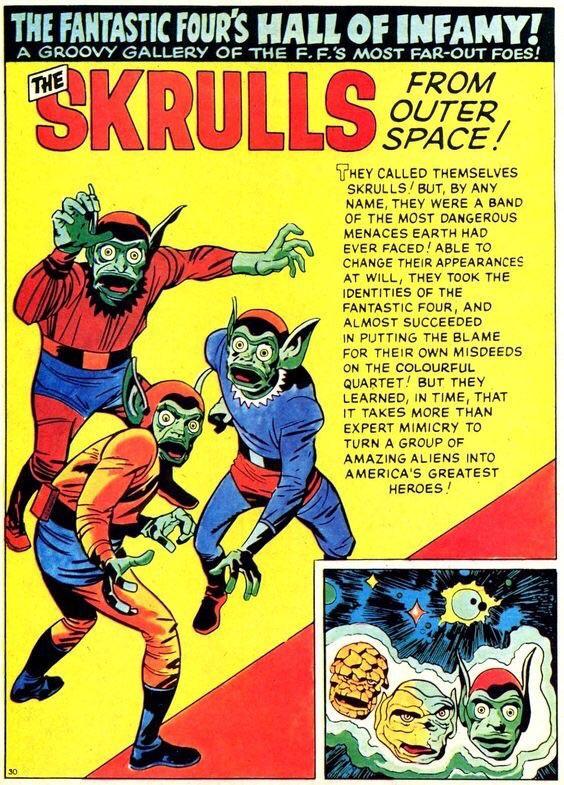
The Skrulls’ first information page. Dawn by Jack Kirby – from FF Annual #1 – 1963 (c) Marvel Comics
Okay – I know, I know – Skrulls wear clothes, and every Skrull appearance will in no way stand up to this classification and needs of the inhabited planet. Hey – this is about how many Skrulls there are, not Skrull physiology. You want to read something on Skrull physiology…heck, just probably check back here in a while.
So – “suitable” worlds, for the sake of argument = “earth-like” worlds, a.k.a., the only worlds we know of that are suitable to reptilian life. Now we just need to get a handle on how many earth-like worlds are out there to get some kind of baseline in regards to the number of Skrulls in Andromeda.
So…how many earth-like exo-planets are out there? We have a sample we can use for a bare-bones estimate. We’ve got eight (or nine, I know, Pluto people) planets in our solar system, and one is earth-like. Alright, perhaps three (Venus, Earth, and Mars) at one time, but now, we’ve got one.
What’s “earth-like?” Well, like the earth. When astronomers use the term usually that’s a small handful of characteristics: similar in size (and thus gravity, so a radius 75% – 150% of earth’s) an atmosphere capable of sustaining life as we know it (in this case, reptilian life as we know it), ingredients suitable for life, and a distance from its star to ensure the presence of liquid water. There are, of course, other pieces to the puzzle of life on earth, but those are the majors. Again – in our solar system, we know of one.
Estimates of how many planets there are in the Milky Way follow along this line of reason. We’ve got eight (sigh, or nine), and we have no evidence to indicate that our solar system is anything more than average. So – it can be as simple as that: the number of stars in a galaxy multiplied by eight. That’s a tempting road to go down, and there may be nothing wrong with it as an average (some stars may have three, some none). The Trappist star system, originally discovered in 2015 has at least seven planets, six of which could be in the star’s optimistic habitable zone, and at least one is earth-like. The star designated Kepler-32 has five planets orbiting it. That said, more often, astronomers will err on the side of caution and call it at around 25%-50% of sun-like stars have earth-like planets orbiting them.
Yeah, about those stars? Not every star is like our sun, so therefore, not every set of planets could have a potentially earth-like planet in its system. An estimate for the Milky Way suggests that around 20% – 25% of the stars are similar to our sun (called F, G, or K-class stars). So for our galaxy, that trims the 100-400 billion stars to perhaps 250,000,000 to 1 billion sun-like stars, with a quarter to half of them possibly having earth-like planets in their respective systems. So – in the Milky Way, that’s possibly 63,000,000 to 250,000,000 planets that would be considered “suitable” by Reed Richards.
As for the Skrulls’ home galaxy? Bump up the top number of stars to a trillion. If we’re going to be conservative-ish, then let’s say 20% of Andromeda’s stars are sun-like, and 25% of those have earth-like planets orbiting them. That’s still 50,000,000,000 – 50 billion planets for the Skrulls to possibly inhabit. On the low side. On the high side, hundreds of billions.
This isn’t any hard and fast, set number. There are a few other considerations to take into account in terms of planets being, and systems allowing for earth-like conditions, such as a protective magnetic field, geological activity perhaps including plate tectonics, the position of the star in the larger galaxy, allowing for protection from damaging or lethal radiation conditions from nearby stars or the galaxy’s central black hole.
But as a ballpark – these numbers aren’t a bad place to start for “suitable” worlds populated by a star-spanning galactic empire that’s billions of years old.
So…Come On! How Many Skrulls?
Is this where I remind you that I told you there was no payoff to the implicit promise of the title?
Seriously, there’s no payoff.
I mean – possibly hundreds of billions of worlds. Some conquered, some discovered and colonized, but billions worlds. How many Skrulls can you fit on one world? Multiply that by a few billion. Your answer is at the very least, informed by real science. Want to be more conservative, take it down to a smaller number of “suitable” worlds, and multiply your planet’s Skrull population by that number.
And yeah, I know – that’s not even counting atmosphere-containing, climate-controlled outposts on otherwise uninhabitable locations, such as asteroids or moons; terraformed planets, dwarf planets, or space stations, where Skrull technology could expand their habitat.
I hope you don’t think this was all pointless – after all, all that you got through to get here? Real, solid science. Cool stuff. If anything – let this fuel a deeper understanding of the cosmology and relationships in the “cosmic” side of the Marvel Universe. The Skrull Empire is beyond ancient in earth terms. The technology needed to conquer a galaxy, let alone keep it running and unified (which has faltered from time to time) in terms of infrastructure, trade, maintaining peace and political order, and economics? That’s just insane.
And what’s happened every time the Skrulls have come to earth? They’ve gotten spanked. First by Richards and the rest of the Fantastic Four, but as the decades have drawn one, virtually every Marvel hero has gotten their chance to, if not punch a Skrull, actively help in pushing back a Skrull invasion. Every single time they come at the earth, for whatever reason, they get beat down. Every. Time. That’s gotta sting.
To me, that adds depth to the stories – I mean, that despite the friend/ally/enemy posturing over the years, the Skrulls must have a special piece of burning hatred in their hearts for the earth, and also, the heroes of the earth are tough. Tougher than the heroes of any world in the Andromeda galaxy that was conquered by the Skrulls, at the very least.
We’ll see how things go this summer in Empyre, as well as see the role the Skrulls play in the coming stores in the Marvel Cinematic Universe, where many fans are thinking the next big storyline will be a movie version of Secret Invasion, but one thing’s for sure – even if an exact number is impossible to come by, there are a lot of Skrulls. And they’re probably carrying an institutional hatred for the earth – the tiny planet that stops them every time.
Update (June 16, 2020)
I fine-tuned the possible number of worlds in Andromeda a little and brought it down for a few reasons to a more conservative value.
Just a few days after this article was published, a new study in The Astrophysical Journal made headlines, claiming that there were 36 alien civilizations in the Milky Way galaxy with technology advanced to the point that they would be capable of communicating with us. The assumption that led the researchers to this conclusion, as Ethan Siegel explains at Forbes, is based on the idea that if you take a sun-like star, wait 5 billion years, you’ll get a technologically-based civilization like us. That conclusion, as Siegel explains in-depth, is not necessarily a safe one, nor a valid one.


